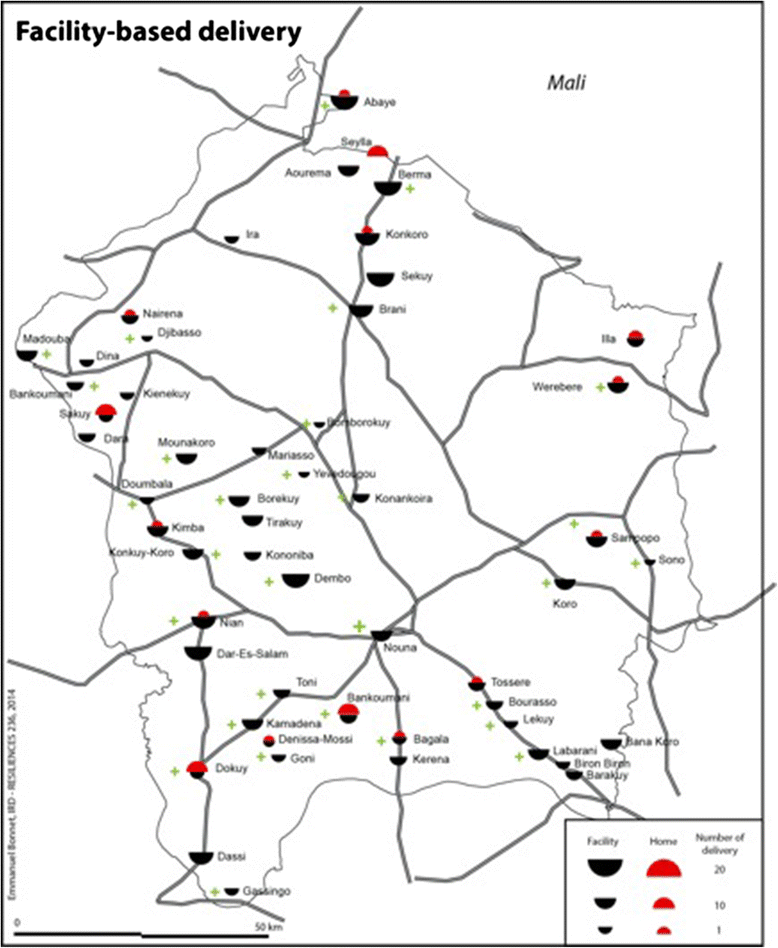Understanding home delivery in a context of user fee reduction: a cross-sectional mixed methods study in rural Burkina Faso
- PMID: 26653013
- PMCID: PMC4676832
- DOI: 10.1186/s12884-015-0764-0
Understanding home delivery in a context of user fee reduction: a cross-sectional mixed methods study in rural Burkina Faso
Abstract
Background: Several African countries have recently reduced/removed user fees for maternal care, producing considerable increases in the utilization of delivery services. Still, across settings, a conspicuous number of women continue to deliver at home. This study explores reasons for home delivery in rural Burkina Faso, where a successful user fee reduction policy is in place since 2007.
Methods: The study took place in the Nouna Health District and adopted a triangulation mixed methods design, combining quantitative and qualitative data collection and analysis methods. The quantitative component relied on use of data from the 2011 round of a panel household survey conducted on 1130 households. We collected data on utilization of delivery services from all women who had experienced a delivery in the previous twelve months and investigated factors associated with home delivery using multivariate logistic regression. The qualitative component relied on a series of open-ended interviews with 55 purposely selected households and 13 village leaders. We analyzed data using a mixture of inductive and deductive coding.
Results: Of the 420 women who reported a delivery, 47 (11 %) had delivered at home. Random effect multivariate logistic regression revealed a clear, albeit not significant trend for women from a lower socio-economic status and living outside an area to deliver at home. Distance to the health facility was found to be positively significantly associated with home delivery. Qualitative findings indicated that women and their households valued facility-based delivery above home delivery, suggesting that cultural factors do not shape the decision where to deliver. Qualitative findings confirmed that geographical access, defined in relation to the condition of the roads and the high transaction costs associated with travel, and the cost-sharing fees still applied at point of use represent two major barriers to access facility-based delivery.
Conclusions: Findings suggest that the current policy in Burkina Faso, as similar policies in the region, should be expanded to remove fees at point of use completely and to incorporate benefits/solutions to support the transport of women in labor to the health facility in due time.
Figures
Similar articles
-
User fee exemptions and excessive household spending for normal delivery in Burkina Faso: the need for careful implementation.BMC Health Serv Res. 2012 Nov 21;12:412. doi: 10.1186/1472-6963-12-412. BMC Health Serv Res. 2012. PMID: 23171417 Free PMC article.
-
The impact of user fee removal policies on household out-of-pocket spending: evidence against the inverse equity hypothesis from a population based study in Burkina Faso.Eur J Health Econ. 2015 Jan;16(1):55-64. doi: 10.1007/s10198-013-0553-5. Epub 2014 Jan 12. Eur J Health Econ. 2015. PMID: 24414280
-
Financial accessibility and user fee reforms for maternal healthcare in five sub-Saharan countries: a quasi-experimental analysis.BMJ Open. 2016 Jan 28;6(1):e009692. doi: 10.1136/bmjopen-2015-009692. BMJ Open. 2016. PMID: 26823178 Free PMC article.
-
[Health system revenue collection in Burkina Faso from 1980 to 2012].Sante Publique. 2014 Sep-Oct;26(5):715-25. Sante Publique. 2014. PMID: 25490231 Review. French.
-
A systematic review of the effect of performance-based financing interventions on out-of-pocket expenses to improve access to, and the utilization of, maternal health services across health sectors in sub-Saharan Africa.J Glob Health. 2023 May 5;13:04035. doi: 10.7189/jogh.13.04035. J Glob Health. 2023. PMID: 37143430 Free PMC article.
Cited by
-
Effects of terrorist attacks on access to maternal healthcare services: a national longitudinal study in Burkina Faso.BMJ Glob Health. 2020 Sep;5(9):e002879. doi: 10.1136/bmjgh-2020-002879. BMJ Glob Health. 2020. PMID: 32978211 Free PMC article.
-
Barriers and facilitators to preventive interventions for the development of obstetric fistulas among women in sub-Saharan Africa: a systematic review.BMC Pregnancy Childbirth. 2018 May 10;18(1):155. doi: 10.1186/s12884-018-1787-0. BMC Pregnancy Childbirth. 2018. PMID: 29747604 Free PMC article.
-
"Who'll do all these if I'm not around?": Bonding social capital and health and well-being of inpatients.Int J Qual Stud Health Well-being. 2018 Dec;13(1):1435108. doi: 10.1080/17482631.2018.1435108. Int J Qual Stud Health Well-being. 2018. PMID: 29447613 Free PMC article.
-
Access barriers to obstetric care at health facilities in sub-Saharan Africa-a systematic review.Syst Rev. 2017 Jun 6;6(1):110. doi: 10.1186/s13643-017-0503-x. Syst Rev. 2017. PMID: 28587676 Free PMC article.
-
Effect of emergency obstetric care and proximity to comprehensive facilities on facility-based delivery in Malawi and Haiti.PLOS Glob Public Health. 2022 Feb 2;2(2):e0000184. doi: 10.1371/journal.pgph.0000184. eCollection 2022. PLOS Glob Public Health. 2022. PMID: 36962282 Free PMC article.
References
-
- Thiede M, Koltermann KC. Access to health services—Analyzing non-financial barriers in Ghana, Rwanda, Bangladesh and Vietnam using household survey data. A review of the literature. New York: UNICEF; 2013. p. 61.
Publication types
MeSH terms
Grants and funding
LinkOut - more resources
Full Text Sources
Other Literature Sources
Medical


